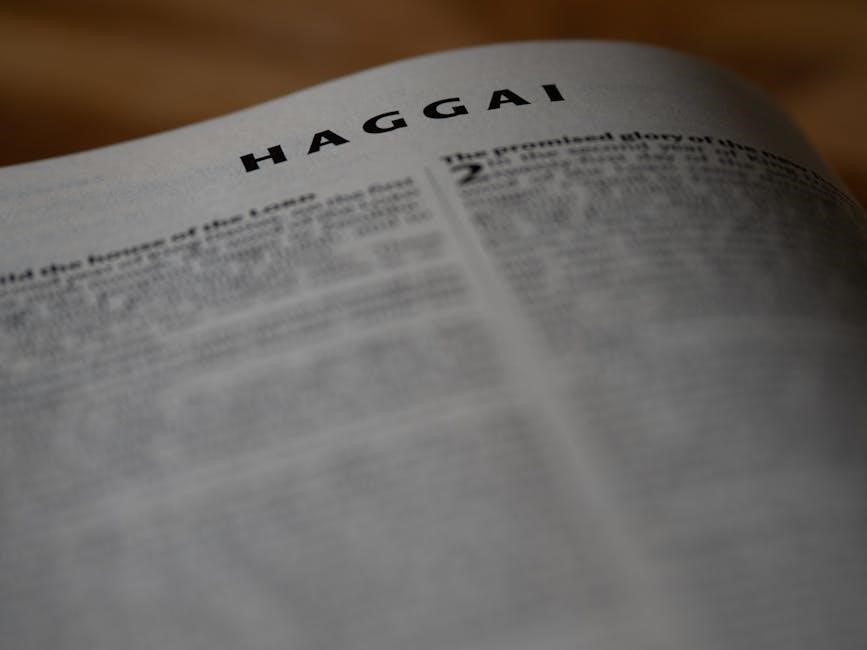Central to the New Testament’s portrayal of Jesus is the claim that He fulfilled Old Testament prophecies. However, many verses interpreted as messianic in the New Testament were not originally understood that way in the Old Testament. This re-contextualization reshaped Jewish expectations of the Messiah, emphasizing themes of suffering and redemption over political deliverance.

The Role of Prophecy in the Old Testament
Old Testament prophecies often focus on themes like justice, redemption, and a coming righteous leader. Jewish expectations of a messiah emphasized political and religious restoration, not divine intervention or suffering. These predictions provided a framework for understanding God’s plan within Israel’s historical context.
2.1 Messianic Expectations in the Old Testament
Messianic Expectations in the Old Testament
Messianic expectations in the Old Testament were rooted in the hope of a future deliverer who would restore Israel’s glory and establish God’s kingdom on earth. The Messiah was anticipated as a divine ruler descended from King David, tasked with defeating enemies and ushering in an era of peace and prosperity. Texts like Isaiah 9 and Zechariah 9 contributed to these visions, emphasizing a strong, wise, and victorious leader. However, many of these expectations were not fulfilled as intended in the New Testament, as Jesus embodied a different kind of kingship centered on sacrifice and redemption rather than political power and triumph. This shift reshaped Jewish and early Christian understanding of the Messiah’s role.
2.2 Apocalyptic and Eschatological Themes
Apocalyptic and eschatological themes in the Old Testament, such as those in Daniel and Isaiah, often depict the “end times” and a “day of the Lord” marked by judgment and deliverance. These visions, including the “Son of Man” imagery in Daniel, were reinterpreted in the New Testament to symbolize Jesus, especially in His Olivet Discourse. The New Testament expands on these themes, presenting the ultimate fulfillment of apocalyptic expectations through Jesus’ death and resurrection, which inaugurate a new eschatological era. Whereas the Old Testament anticipated a national restoration for Israel, the New Testament universalizes this fulfillment, focusing on spiritual redemption for all humanity. This shift challenges traditional Messianic expectations, emphasizing a cosmic/eschatological reality rather than a political restoration, thereby shaping early Christian theology centered on the church as the manifestation of God’s eschatological promises within this age, while awaiting the final culmination in the new age.
2.3 The Davidic Covenant and Messianic Lineage
The Davidic Covenant, established in 2 Samuel 7, promised an eternal dynasty for King David and his descendants, emphasizing God’s promise of a perpetual throne. This covenant became central to messianic expectations, as the Messiah was expected to descend from David’s line and restore Israel’s glory. The New Testament identifies Jesus as the fulfillment of this promise, claiming His lineage from David and his royal house. However, the New Testament reinterprets the covenant’s fulfillment, emphasizing Jesus’ spiritual kingship and the establishment of a new covenant. This reframing challenges traditional expectations, presenting the Davidic promise as ultimately realized in Christ’s divine and human nature, culminating in the church as the spiritual kingdom of God. Vatican I further solidified this view, affirming Christ’s dual nature as the fulfillment of the Davidic covenant in a way that transcended political monarchy, instead emphasizing His role as the eternal spiritual ruler. These reinterpretations reshaped the understanding of messianic lineage and its fulfillment in light of the New Testament’s theological developments.
2.4 Typology and Symbolism in Old Testament Prophecy
Typology and symbolism in Old Testament prophecy serve as profound tools for interpreting the deeper meanings behind historical events and figures. Typology identifies Old Testament events or individuals as foreshadowings of New Testament realities, highlighting recurring patterns and parallels that point toward Jesus. For instance, the exodus event is seen as a type of Jesus leading His people out of the bondage of sin. Symbolism, on the other hand, uses objects like the ark, the Temple, or sacrifices to represent deeper spiritual truths that find their fulfillment in Christ. These symbols and typological connections create a rich narrative tapestry, illustrating how Jesus fulfills the symbolic and typological elements of the Old Testament. The New Testament frequently employs typological interpretations, such as viewing Jesus as the true Temple, the true bread from heaven, or the true vine. This approach underscores themes that are developed and completed in Jesus and His church, emphasizing the continuity and fulfillment of Old Testament prophecies in the New Testament. Through typology, the New Testament writers not only fulfill specific predictions but also resonate with the symbolic patterns established in the Old Testament, enriching the understanding of divine revelation and its progressive unfolding. This method of interpretation allows for a deeper appreciation of how the biblical narrative unfolds, illustrating a grand symphony of themes that reach their culmination in Jesus. Thus, typology and symbolism are integral to comprehending the multifaceted fulfillment of Old Testament prophecies in the New Testament.

The Fulfillment of Old Testament Prophecies in the New Testament
New Testament fulfillment reinterprets Old Testament prophecies, often redefining messianic expectations with themes of suffering and redemption over political deliverance.
3.1 Jesus as the Messiah: The Fulfillment of Messianic Prophecies
The New Testament presents Jesus as the fulfillment of Old Testament messianic expectations. While many OT prophecies were not originally intended to describe the Messiah, NT authors reinterpret them to reveal Jesus as the ultimate fulfillment. For instance, the virgin birth (Isaiah 7:14) and the Bethlehem birth (Micah 5:2) align with Jesus’ origins. The suffering servant in Isaiah 53 reflects His sacrificial death. Yet, Jesus fulfilled these in ways that reshaped messianic understanding, emphasizing spiritual redemption over political triumph. His role as the Lamb of God and the risen Messiah fulfilled atonement and resurrection themes central to Israel’s hope.
3.2 The Virgin Birth and Its Fulfillment
The virgin birth of Jesus, recorded in Matthew and Luke, is seen as a fulfillment of Isaiah 7:14, which mentions a “virgin shall conceive and bear a son.” While this prophecy originally referred to an immediate historical context, Christian theology interprets it as a Messianic foretelling. The New Testament emphasizes Mary’s role as a virgin, fulfilling the prophecy literally, while Jewish tradition does not recognize such fulfillment. This interpretation highlights the unique Christian understanding of Jesus’ divine nature and the fulfillment of Old Testament promises in the New Covenant.
3.3 The Suffering Servant in Isaiah and Its Fulfillment in Christ
Isaiah 53 presents a figure of a suffering Servant, often interpreted in the New Testament as a prophecy fulfilled in Jesus Christ. While the original context of ISAiah 53 referred to a collective Israel or an idealized historical figure, Christian theology identifies it as a messianic prophecy. The New Testament highlights Jesus’ voluntary suffering and death as the ultimate fulfillment of this prophecy, emphasizing His role as the Suffering Servant who bears the sins of the world. Early Christian writers, such as Luke and the Apostle Paul, draw parallels between the Servant’s sacrifice and Christ’s redemptive work. This fulfillment underscores the theological significance of Jesus’ mission, yet Jewish interpretations often view the passage as distinct from messianic expectations, reflecting differing hermeneutical approaches to Scripture.

Theological Implications of Prophecy Fulfillment
The fulfillment of Old Testament prophecies in the New Testament redefined Messianic expectations. The concept of the suffering servant shifted from a political to a redemptive figure, challenging traditional views of a conquering Messiah. This fulfillment underscores the theological significance of atonement and the inauguration of the Kingdom of God as a spiritual reality.
4.1 Messianism in the New Testament
The New Testament redefines Messianism, presenting Jesus as both fulfillment and redefinition of Old Testament expectations. Jesus’ crucifixion and resurrection reshaped Messianic identity, emphasizing redemptive sacrifice over political rule. The early church interpreted these events as fulfillments of Old Testament prophecies, bridging Jewish and Christian understandings. This theological shift underscores Christ’s role as the ultimate Messiah, bringing spiritual salvation and inaugurating the Kingdom of God beyond earthly expectations.
4.2 The Concept of Atonement in the Light of Prophecy Fulfillment
The New Testament reinterprets Old Testament atonement as fulfillment of prophecies through Jesus’ life and death. Distinct from Jewish expectations of a political Messiah, Jesus’ sacrifice became the ultimate atonement for sin. Isaiah’s suffering servant (Isaiah 53) is central, Jesus as bearing others’ sins. This recontextualization positions atonement as a spiritual redemption rather than mere deliverance, reshaping Messianic prophecy into a theological framework of grace and salvation. It transforms Old Testament sacrificial systems into a fulfillment-oriented soteriology, emphasizing Christ’s.
4.3 The Kingdom of God and Eschatology in the New Testament
The New Testament reinterprets Old Testament eschatological promises through the lens of Christ’s reign and the Kingdom of God. It emphasizes the fulfillment of prophecies through Jesus’ life, death, and resurrection, viewing His rule as the ultimate answer to Old Testament hopes for restoration. Whereas the Old Testament anticipated a Messianic Kingdom centered on Israel, the New Testament presents a universal Kingdom, spiritual in nature, accessible through faith. This reframing highlights the transformative power of the Gospel, positioning Jesus as the inaugurator of the Kingdom, which believers enter through Him. Eschatology in the New Testament thus becomes a fulfillment of Old Testament hopes, yet reoriented toward a spiritual and eternal reality.

Challenges to the Traditional View of Prophecy Fulfillment
Modern scholars question the straightforward fulfillment of Old Testament prophecies in the New Testament, emphasizing historical and cultural contexts that differ from traditional interpretations. Some reinterpret prophecies theologically, focusing on deeper themes rather than literal fulfillments. Jewish perspectives often highlight differences in Messianic expectations, complicating the narrative of direct fulfillment. These challenges prompt reevaluations of the theological implications and historical narratives surrounding prophecy fulfillment.
5.1 Modern Scholarly Perspectives on Prophecy Fulfillment
Modern scholars critically examine the traditional view of Old Testament prophecies being fulfilled in the New Testament. They emphasize the historical and cultural contexts that influence interpretation, often questioning direct fulfillments. Jewish and Christian perspectives diverge significantly, especially regarding the Messiah’s role. Scholars highlight how New Testament authors reinterpreted Old Testament texts to align with Jesus’s life and mission, reshaping Messianic expectations. Historical-critical methods further reveal alternative interpretations, challenging the theological assumptions of prophecy fulfillment. These perspectives underscore the dynamic evolution of religious thought and the complexities of textual analysis.
5.2 Jewish Interpretations of Messianic Prophecies
Jewish interpretations of Messianic prophecies differ significantly from Christian understandings. In Jewish tradition, the Messiah is expected to be a human leader who will restore Israel, rebuild the Temple, and usher in an era of peace and justice. Jewish sources emphasize a political and national savior, not a divine figure or a suffering Messiah. This contrasts sharply with Christian beliefs
The New Testament’s reinterpretation of Old Testament verses as Messianic prophecies fulfilled in Jesus often conflicts with Jewish exegetical traditions. For Jews, the Messiah is not anticipated to die or rise from the dead but to establish a one-world government under Israel’s rule. These divergent understandings highlight the theological chasm between Jewish and Christian interpretations of Messianic expectations.
5.3 Historical and Cultural Context of Prophecy Fulfillment
The historical and cultural context of prophecy fulfillment is crucial to understanding the New Testament’s interpretation of Old Testament texts. The 1st-century Palestinian setting shaped how early Christians viewed Jesus as the Messiah, despite His crucifixion contradicting Jewish expectations of a political deliverer. The New Testament reinterpreted Jewish messianic hopes, emphasizing themes of suffering and redemptive sacrifice instead of military or political triumph.
Historical events, such as the destruction of the Second Temple in 70 CE, influenced how early Christians recontextualized Old Testament prophecies. The New Testament’s reworking of these prophecies reflects the challenges of grappling with Jesus’ unexpected role as a crucified Messiah and a spiritual savior, reshaping Jewish theological frameworks into a new Christian narrative of fulfillment. This adaptation highlights the dynamic interplay between tradition and innovation in early Christian theology.

Specific Old Testament Prophecies and Their Fulfillment
Specific Old Testament prophecies include Isaiah 7:14 (virgin birth), Micah 5:2 (Bethlehem), Psalm 22 (crucifixion), and Zechariah 9:9 (triumphal entry), fulfilled in the New Testament.
6.1 Isaiah 7:14 and the Virgin Birth
Isaiah 7:14 prophesies, “Behold, a virgin shall conceive, and bear a son, and shall call his name Immanuel.” This prophecy was understood by Israelites as a sign from God during King Ahaz’s reign. However, the New Testament, particularly in Matthew 1:22-23, identifies this prophecy’s fulfillment in the virgin birth of Jesus. Mary’s conception through the Holy Spirit and Joseph’s obedience to marry her despite the circumstances underscore the miraculous nature of this fulfillment. It highlights God’s intervention in human history to redeem humanity, aligning with messianic expectations while redefining them through divine action.
6.2 Micah 5:2 and the Birth of Jesus in Bethlehem
Micah 5:2 states, “But you, Bethlehem Ephrathah, though you are small among the clans of Judah, out of you will come for me one who will be ruler over Israel.” This prophecy, originally referring to a future king, took on messianic significance in the New Testament. Matthew 2:6 cites Micah 5:2 to affirm that Jesus, born in Bethlehem, fulfilled this prophecy. The historical coincidence of Joseph and Mary traveling to Bethlehem for the census, aligning with the prophecy, highlights God’s sovereignty in fulfilling His promises. Jesus’ birth in Bethlehem underscores the fulfillment of messianic expectations and the divine plan of redemption for humanity.
6.3 Psalm 22 and the Crucifixion
Psalm 22 is a powerful messianic prophecy that finds fulfillment in Jesus’ crucifixion. The psalm describes a righteous sufferer, crying out, “My God, my God, why have you forsaken me?” This verse, quoted by Jesus as He hung on the cross, aligns with the fulfillment of prophecy. Additional details, like the piercing of hands and feet and the division of garments, match the events of the crucifixion (Matthew 27:35). Far from being a coincidence, the New Testament sees these parallels as evidence of divine orchestration. The fulfillment of Psalm 22 demonstrates how Jesus’ sacrifice fulfilled ancient expectations and established the theological foundation of redemption through suffering.
6.4 Zechariah 9:9 and the Triumphal Entry

Zechariah 9:9, a messianic prophecy, vividly describes the arrival of a humble king entering Jerusalem on a donkey, declaring peace. This prophecy found its fulfillment in Jesus’ triumphal entry (Matthew 21:1-5; John 12:14-15; Luke 19:28-35). By riding into Jerusalem on a donkey, Jesus deliberately contrasted His humble, non-violent kingship with the expectations of a conquering Messiah. The New Testament authors recognized this act as a deliberate fulfillment of Zechariah’s prophecy, highlighting Jesus’ identity as the long-awaited Messiah. This event underscored the paradox of the kingdom of God, emphasizing peace, humility, and fulfillment of ancient expectations through a radically different Messiah.

The Role of the Apostles in Connecting Old and New Testament Prophecies
The apostles skillfully interpreted Old Testament texts to reveal Jesus as the fulfillment of prophecy. Peter, Paul, and others used OT references to demonstrate Christ’s identity and mission. Their teachings bridged Jewish expectations with the Gospel, reshaping understanding of the Messiah in light of Jesus’ crushed and resurrected reality.
7.1 Peter’s Use of Old Testament Prophecy in His Teachings
Peter, as a key apostle, employed Old Testament prophecy to affirm Jesus’ identity and message. He interpreted OT texts, such as Joel 2 and Psalm 16, as pointing to Christ’s resurrection and role as the Messiah. His teachings bridged Jewish expectations with the Gospel narrative, emphasizing how Jesus fulfilled long-awaited Messianic promises. Peter’s use of OT imagery and typology highlighted the fulfillment of God’s plan in the life and mission of Jesus.
7.2 Paul’s Use of Prophecy in His Letters
Paul skillfully employed Old Testament prophecy in his epistles to emphasize the fulfillment in Jesus. He often reinterpreted OT texts, like Isaiah’s “slain Messiah,” to align with Christ’s sacrificial role. Paul used typology, such as Adam as a type of Christ, to bridge Old and New Testament themes. By framing Christ as the culmination of OT expectations, Paul demonstrated how God’s redemptive plan unfolded through Jesus, solidifying his messianic identity and the transformative Gospel message.
7.3 The Book of Hebrews and Its Use of Old Testament Themes
The Book of Hebrews masterfully employs Old Testament themes to bridge the Old and New Testaments. It emphasizes typology and symbolic references, such as the priesthood of Melchizedek and the Tabernacle as a shadow of Christ’s ministry. By recontextualizing these themes, Hebrews portrays Jesus as the ultimate fulfillment of Old Testament types, the perfecthigh priest, and the ultimate sacrifice. Throughthis lens, the author demonstrates how Jesus’ life and work fulfill the promises and patterns of the Old Testament, solidifyingHis role as the Messiah and redeemer of humanity.

Modern Interpretations and Debates
Modern debates question the extent to which Jesus fulfilled Old Testament prophecies as traditionally understood. Historical–critical methods highlight that many New Testament citations recontextualize Old Testament passages not originally intended as messianic, sparking Jewish–Christian theological debates over prophecy fulfillment and its significance.
8.1 Historical-Critical Methods in Studying Prophecy Fulfillment
Historical-critical methods challenge traditional views of Old Testament prophecy fulfillment by critically examining the context and intent of biblical texts. Scholars argue that many New Testament citations of Old Testament verses often recontextualize them, interpreting passages as messianic that were not originally so. This approach highlights that the Old Testament lacks a clear or coherent messianic concept, and many expectations of the Messiah, such as rebuilding the Temple or establishing peace, were not fulfilled by Jesus. These methods question the assumption of direct fulfillment and reinterpret the theological significance of prophecy in light of historical and cultural contexts.
8.2 The Role of Prophecy in Christian Theology Today
In, fulfillment faith redemptive plan 。 modern scholars challenge traditional fulfillments, many Christians view these prophecies as divine foreshadowings of Jesus’ life, death, and resurrection. Themes of redemption, suffering, and eschatological hope remain central to Christian theology, with Jesus as the ultimate fulfillment of messianic promises. While debates persist over precise fulfillments, the enduring relevance of these prophecies lies in their ongoing guidance and inspiration for believers. The recognition that Jesus’ crucifixion and resurrection transformed messianic expectations continues to shape contemporary theological discourse, emphasizing God’s unexpected and profound work through Christ.
8.3 Jewish and Christian Perspectives on Messianic Prophecies
Jewish and Christian interpretations of Messianic prophecies differ significantly. While Jews view the Messiah as a future ruler who will restore Israel and bring global peace, Christians believe Jesus fulfilled these expectations through his life, death, and resurrection. Jewish tradition emphasizes a political and national Messiah, not expecting a suffering or divine figure. Christians, however, see Jesus as the ultimate fulfillment, reinterpreting Old Testament prophecies to fit their beliefs. This divide highlights conflicting expectations, as Jews traditionallyawait a Messiah who will rebuild the Temple, while Christians believe Jesus already fulfilled the spiritual aspects of these prophecies. These differing perspectives reveal enduring theological and interpretive challenges.
8.4 The Debate Over Prophecy Fulfillment and Its Significance
The debate over Old Testament prophecy fulfillment remains contentious. Some scholars argue that New Testament authors reinterpreted Old Testament texts to fit Jesus’ life, often reshaping their original meanings. Critics contend that many “fulfilled” prophecies were not originally messianic or were taken out of context. Others emphasize the spiritual significance of these fulfillments as a divine plan. Jewish perspectives often question Christian interpretations, viewing them as misapplications. Theological implications include questions about prophecy’s reliability and the nature of Jesus’ Messiahship. This debate underscores both the complexity ofscripture and potential misunderstandings between Jewish and Christian traditions.

The fulfillment of Old Testament prophecies in the New Testament serves as a foundational pillar of Christian theology, yet it remains a complex and often debated topic. New Testament authors reinterpreted Old Testament texts to assert that Jesus fulfilled messianic and eschatological expectations. This re-contextualization reshaped traditional Jewish ideas of the Messiah, emphasizing themes of suffering, redemption, and resurrection over political deliverance. While some scholars affirm these fulfillments as divinely intended, others critique them as interpretive readings that Departed from the original contexts. The significance lies in how these fulfillments challenge and evolve understanding of scripture, Messiahship, and the nature of divine plan. Ultimately, they continue to shape Christian identity and theological discourse while inviting deeper engagement with the interplay of Old and New Testaments.





